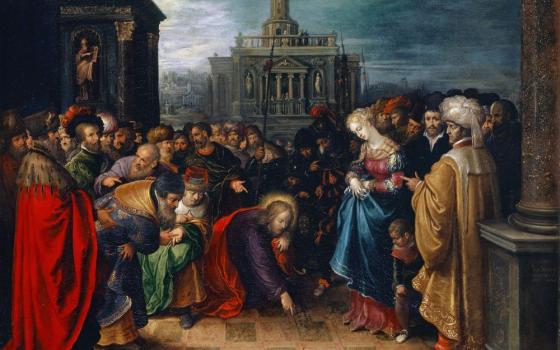
Benedictine Br. David Steindl-Rast, right, bows to the Dalai Lama at a talk on "Beyond Religion: Ethics, Values, and Wellbeing" in Boston, Oct. 14, 2012. (Flickr/Christopher Michel)

The enigmatic title of Benedictine Br. David Steindl-Rast's new memoir, i am through you so i, is taken from a line of e.e. cummings' poetry and was selected because it sums up the author's belief: I become who I am through you. As Steindl-Rast admits, this book is not exactly an autobiography but rather a long interview about his life and work. Since the style is conversational, the writing is accessible, and the probing questions of the interviewer, Johannes Kaup, save it from many of the limits of autobiography.
The book's scope covers Steindl-Rast's 90 years, beginning with his birth in Austria in 1926, early family life, his parents' divorce, and the influence of traditional Catholicism in inculcating a trust in life and an experience of mystery. This secure and protected world was upended by the Second World War, and since he was one-fourth Jewish, a "mixed-breed," life was tenuous. Although recruited into the German army, he never saw combat.
After the war he finished his education, earned a Ph.D. in psychology from the University of Vienna and immigrated with his family to the United States in 1952. A year later, predisposed as he was to stability and the need for structure, he entered the newly established Benedictine monastery of Mount Saviour in Pine City, New York, determined to live the original Rule of Benedict.
Living through the war, confronting death and suffering and the precariousness of life, Steindl-Rast was forced to live in the moment. Likewise, in his new monastic life, where life was governed by the rhythm of nature, he experienced a transcendence of time. The monastery became for him a place where living in the now was practiced.
During the late 1960s, Steindl-Rast studied Buddhism for three years and began his lifelong commitment to interfaith dialogue. Ultimately that dialogue was broadened to include Hindus, Jews and Muslims. Increasingly he lectured outside the monastery, founding both the Center for Spiritual Studies and the House of Prayer Movement. He explains that the particular Benedictine vow of stability meant a lasting vow to membership in the community, not necessarily a vow to live in one place. He came to spend more time in various monastic communities, especially the New Camaldoli Hermitage in Big Sur, California, where he lived for 14 years.
As a Benedictine, Steindl-Rast spent half the year as a hermit in a monastery but spent the other half traveling to three continents, lecturing and giving workshops and retreats. It was through this extensive global interaction that both his breadth and depth were augmented. He saw the similarities among the world's various religions and identified the human response of gratitude as essential to all human life and a part of the religious worldview.
As a universal phenomenon, accessible to young and old, gratefulness connects each person to all living things and helps one to live in the present and face life with trust and joy. For Steindl-Rast, gratefulness is a prelude to happiness, not vice versa. It is discovered by living in the now.
Advertisement
This book gives the reader a sense of this remarkable man; nonetheless one wants to probe further. What was the reaction of his fellow brothers to his peripatetic life? How did the institutional church authorities respond to his work? One wants to know more about his life in the German army and his difficult decision to reject family life in order to embrace the monastic vocation. Answers to these questions may only be forthcoming from future biographers.
The importance of his book is in how Steindl-Rast's important insights on gratefulness emerge from his life. By the mid-1980s, rather than retreat into retirement, he began to write and lecture about gratefulness and he established "A Network for Grateful Living" to encourage and guide such commitment. These contributions comprise his legacy. His belief is that if one lives in the now, trusts life itself and says yes to it, then one will live with gratefulness, and the self and the community will become whole. Such gratefulness will confirm as well the claim of Jesus: "I am making all things new."
[Dana Greene's biography, Elizabeth Jennings: The Inward War is forthcoming from Oxford University Press.]






